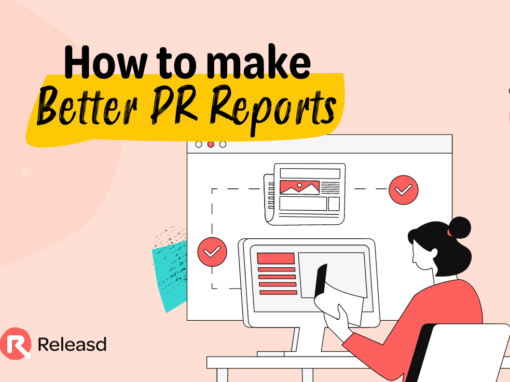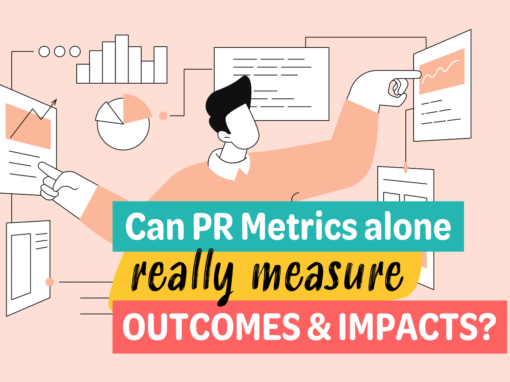Measuring public relations effectiveness is essential to communicating with clients and executives. With more data points at their fingertips than ever before, it’s never been easier to pull up PR metrics at the drop of a hat. Despite this, many PR professionals still do not accurately measure their PR success – with some relying on outdated metrics that are irrelevant in this digital-centric world.
When it comes to measuring public relations effectiveness, it’s important to get with the times. If PRs are not at the forefront of PR measurement trends, they risk undermining the value of their work. Fortunately, there is now a broad range of tools PRs can leverage to become more innovative in how they evaluate PR success and communicate their value to clients.
In the past few years, PR agencies and in-house teams have used thousands of PR KPIs to measure success. How do we know this? Well, Releasd is in a very unique position in the PR industry. As the creator of a dynamic PR reporting tool, we enable PR professionals to build interactive reports with fully customisable KPIs. That leaves us with a treasure trove of data.
We’ve seen it all. With so much data at our disposal, we took a deep dive into the numbers and began to identify some interesting PR measurement trends. Which PR KPIs are on the rise? Do these KPIs align with best practices? Are PRs still using AVE? We’ve got data-backed answers for all these questions and we’ll circle back to this later on.
Measuring Public Relations Effectiveness (Why Does It Matter?)
Reporting for the sake of reporting is not an effective strategy. To understand why measuring PR success matters, PRs need to know the purpose it serves. When measurement is done well, it increases their chances of success. No matter the budget, PRs must begin by identifying what they are trying to achieve with a campaign. Only then can they know what success looks like.
Underscore The Value Of Public Relations
By measuring PR success, they can underscore the value of their public relations work. There is no replacement for quantitative results. It’s their responsibility to have the necessary tools to measure PR success and show the impact of their efforts. If PRs are using the right tools, this will enable them to present the most relevant data points and results.
Improve Agency-Client Relationships
For those working at an agency, demonstrating results is key to client relationships. The clients must know they are getting a return on their investment in campaigns. When PRs have a clear and consistent approach to metrics, this can help to get clients on the same page. PRs can lead with metrics in their client conversations and take a data-driven approach to decision-making.
Leverage Performance Data
Performance data should inform all PR activities. Without access to data, PRs are essentially flying blind. They can leverage data to establish performance trends and help guide their PR efforts. After all, knowledge is power. If PRs are well-equipped with performance data, they can steer their PR campaigns in the right direction and elevate them to new heights.
How To Measure Public Relations Performance
PR professionals are using several different types of KPIs to measure their coverage. Over the past six years, agencies and in-house teams have used over 400,000 individual KPIs in their PR reports with Releasd. Upon analysing these KPIs, we were able to put them into groups. Here are some examples of the different PR KPIs used by agencies and in-house teams:
Activity-Based KPIs
Even though activity-based KPIs may not evaluate business outcomes, they still provide us with insights into the journey the PR industry has recently been on. The global pandemic resulted in the increased use of activity-based KPIs. Our dataset, spanning six years, has allowed us to gain insights into how PR agencies and in-house teams measured results during the pandemic.
Here are some examples of activity-based KPIs:
- Webinars confirmed
- Awards entries completed
- Press releases distributed
- Samples shared
- Blogs in progress
Output-Based KPIs
Despite AMEC wanting PRs to move beyond output-based KPIs, they are not entirely redundant as a form of measurement. It’s often necessary to know the basic numbers in terms of the volume of coverage achieved purely to provide context to more important metrics (more on them shortly).
Here are some examples of activity-based KPIs:
- Twitter posts
- Facebook posts
- Broadcast coverage
- National coverage
- Regional coverage
Out-Take-Based KPIs
Out-take-based KPIs are on the rise. This is something we’ve covered in our recent industry report. Just a few years ago, out-take-based KPIs were often focused on engagement and reach at a high level. With the emergence of more data sources, PRs are picking out a range of different out-take-based KPIs to include in their reports.
Here are some examples of out-take-based KPIs:
- Coverage views
- Live social engagement
- Dark social activity
Outcome & Impact-Based KPIs
These KPIs measure truly meaningful actions taken by the target audience. These are the holy grail of PR reporting. Our dataset from the last six years shows there has been some improvement in the use of these KPIs – but there is still a long way to go. Speaking with our customers, we found outcome and impact-based KPIs were often used by those who set clear and realistic expectations from the outset and had access to the right tools and people.
Here are some examples of outcome and impact-based KPIs:
- Leads delivered to sales team
- Money raised
- New product or service reviews
Public Relations Measurement Trends (Quantifying PR Worth)
While there is no shortage of opinions in the industry on how to measure PR success, it’s often difficult to understand how PRs are actually measuring their success. We wanted to understand whether industry perceptions aligned with reality. In our industry report on the most popular KPIs in PR, we draw conclusions based on 100,000 PR reports and 400,000 individual KPIs.
PR Measurement Tools & Resources
To understand the lie of the land, PRs need access to our exclusive report on the most popular KPIs in PR. With six years of data, this is the ultimate resource for PRs trying to find a sense of direction in measuring success. Sorry, it’s been six years. We can’t resist hyping this up!
The combination of our PR reporting tool and this industry-leading resource will set you on the right path for 2022.
Oh, and did we mention the full report is totally free?
We don’t want a paywall getting in the way of access to these insights.
Uncover how PRs are measuring their work behind closed doors:
Read our free report on the most popular KPIs in PR.



